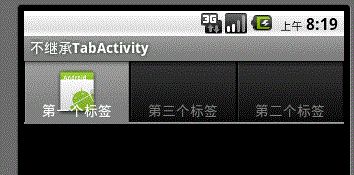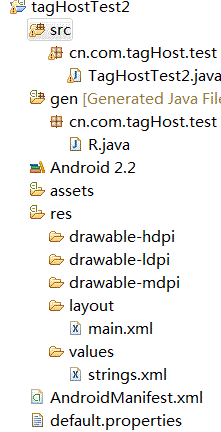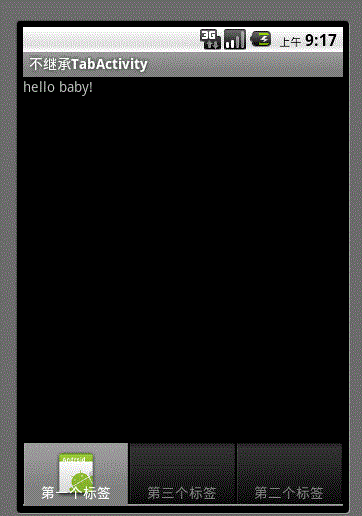android tabHost布局之一 不继承TabActivity并以布局文件进行布局
上图为最终效果图
代码结构图
main.xml
<?xml version="1.0" encoding="utf-8"?> <LinearLayout xmlns:android="http://schemas.android.com/apk/res/android" android:id="@+id/hometabs" android:orientation="vertical" android:layout_width="fill_parent" android:layout_height="fill_parent"> <!-- TabHost必须包含一个 TabWidget和一个FrameLayout--> <TabHost android:id="@+id/tabhost" android:layout_width="fill_parent" android:layout_height="wrap_content" > <LinearLayout android:orientation="vertical" android:layout_width="fill_parent" android:layout_height="fill_parent"> <!-- TabWidget的id属性必须为 @android:id/tabs--> <TabWidget android:id="@android:id/tabs" android:orientation="horizontal" android:layout_width="fill_parent" android:layout_height="wrap_content"> </TabWidget> <!-- FrameLayout的id属性必须为 @android:id/tabcontent--> <FrameLayout android:id="@android:id/tabcontent" android:layout_width="fill_parent" android:layout_height="fill_parent"> <TextView android:id="@+id/view1" android:layout_width="fill_parent" android:layout_height="fill_parent"/> <TextView android:id="@+id/view2" android:layout_width="fill_parent" android:layout_height="fill_parent"/> <TextView android:id="@+id/view3" android:layout_width="fill_parent" android:layout_height="fill_parent"/> </FrameLayout> </LinearLayout> </TabHost> </LinearLayout>
java代码如下
package cn.com.tagHost.test; import android.app.Activity; import android.os.Bundle; import android.widget.TabHost; import android.widget.TabWidget; public class TagHostTest2 extends Activity { @Override public void onCreate(Bundle savedInstanceState) { super.onCreate(savedInstanceState); setContentView(R.layout.main); // 获取TabHost对象 TabHost tabHost = (TabHost) findViewById(R.id.tabhost); // 如果没有继承TabActivity时,通过该种方法加载启动tabHost tabHost.setup(); tabHost.addTab(tabHost.newTabSpec("tab1").setIndicator("第一个标签", getResources().getDrawable(R.drawable.icon)).setContent( R.id.view1)); tabHost.addTab(tabHost.newTabSpec("tab3").setIndicator("第三个标签") .setContent(R.id.view3)); tabHost.addTab(tabHost.newTabSpec("tab2").setIndicator("第二个标签") .setContent(R.id.view2)); } }
运行得到正确的结果。
废话连篇:这里需要注意的是
第一:布局文件的格式。以及TabWidget和FrameLayout的id属性值。
第二:TabWidget代表的是标签部分,FrameLayout代表的点击标签后看到的内容部分。FrameLayout里面声明的组件意为具备成为标签内容的资格,具体的还要在代码中具体指定。
你是否也想要这种结果呢。让标签在下部分显示
那么你只需要给main.xml进行下布局修改就可以了。
main.xml
<?xml version="1.0" encoding="utf-8"?> <LinearLayout xmlns:android="http://schemas.android.com/apk/res/android" android:id="@+id/hometabs" android:orientation="vertical" android:layout_width="fill_parent" android:layout_height="fill_parent"> <!-- TabHost必须包含一个 TabWidget和一个FrameLayout--> <TabHost android:id="@+id/tabhost" android:layout_width="fill_parent" android:layout_height="wrap_content"> <LinearLayout android:orientation="vertical" android:layout_width="fill_parent" android:layout_height="fill_parent"> <!-- FrameLayout的id属性必须为 @android:id/tabcontent--> <FrameLayout android:id="@android:id/tabcontent" android:layout_width="fill_parent" android:layout_height="fill_parent"> <TextView android:id="@+id/view1" android:layout_width="fill_parent" android:layout_height="fill_parent" android:text="hello baby!" /> <TextView android:id="@+id/view2" android:layout_width="fill_parent" android:layout_height="fill_parent" /> <TextView android:id="@+id/view3" android:layout_width="fill_parent" android:layout_height="fill_parent" /> </FrameLayout> <RelativeLayout android:layout_width="fill_parent" android:layout_height="fill_parent"> <!-- TabWidget的id属性必须为 @android:id/tabs--> <TabWidget android:id="@android:id/tabs" android:orientation="horizontal" android:layout_width="fill_parent" android:layout_height="wrap_content" android:layout_alignParentBottom="true" android:paddingBottom="0dp" > </TabWidget> </RelativeLayout> </LinearLayout> </TabHost> </LinearLayout>
为了让标签和父容器底部持平,我们使用了android:layout_alignParentBottom="true",该属性只有在RelativeLayout布局中才会存在哦、这也是为什么我们将tabWidget放入一个RelativeLayout中的原因。
此外,在lineaerLayout布局中,TabWidget和FrameLayout的位置可是调换了哦。


